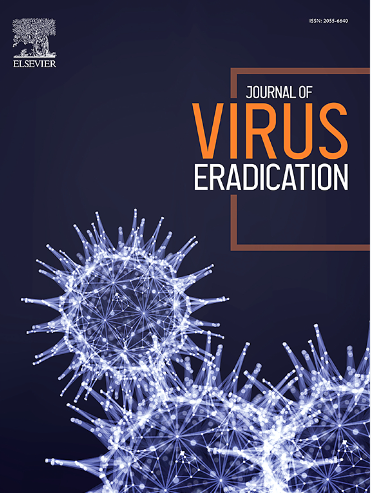分析治疗中断期间血浆病毒血症的程度和持续时间对抗逆转录病毒治疗恢复后CD4+ T细胞恢复的影响
IF 2
4区 医学
Q2 IMMUNOLOGY
引用次数: 0
摘要
目的分析治疗中断(ATI)对评估HIV-1治愈策略的疗效至关重要。最近的治疗研究实施了更灵活的抗逆转录病毒治疗重启标准,允许更长时间内较高的血浆病毒载量(pvl),即使在抗逆转录病毒治疗恢复后,这也可能损害CD4+ T细胞的恢复。我们对包括ATI在内的六项临床HIV治愈试验进行了汇总分析,以评估ATI期间血浆病毒血症的程度和持续时间对CD4+ T细胞动力学的影响。方法采用swilcoxon符号秩和或秩和检验分析3个时间点(1)ati前、2)ART恢复和3)ART诱导病毒再抑制)CD4+ T细胞计数的差异,并按峰值pVL(≤10,000或10,000拷贝/mL)或病毒血症持续时间(0-14、15-28或28天)进行分层分析。在114名参与者中,我们发现从ati前到ati后CD4+ T细胞计数没有变化(在病毒再抑制时,P = 0.80)。我们还发现低(≤10,000拷贝/mL)和高(>10,000拷贝/mL)峰值病毒血症在ART恢复或病毒再抑制时对CD4+ T细胞计数没有影响(P = 0.48, P = 0.88)。同样,从ati前到病毒再抑制的CD4+ T细胞计数的变化在持续0-14天的病毒血症个体与持续28天的病毒血症个体之间没有显著差异。在我们的综合分析中,高峰值反弹pvl和更长的病毒血症持续时间不会损害抗逆转录病毒疗法恢复后CD4+ T细胞的恢复,支持更灵活的ATIs在HIV-1治愈试验中的安全性。本文章由计算机程序翻译,如有差异,请以英文原文为准。
The impact of magnitude and duration of plasma viremia during analytical treatment interruptions on CD4+ T cell recovery after ART resumption
Objective
Analytical treatment interruption (ATI) is crucial for assessing the efficacy of HIV-1 cure strategies. Recent cure studies have implemented more flexible ART restart criteria, permitting higher plasma viral loads (pVLs) for longer periods, which could potentially impair CD4+ T cell recovery even following ART resumption.
Design
We conducted a pooled analysis of six clinical HIV cure trials that included an ATI to evaluate the impact of magnitude and duration of plasma viremia during ATI on CD4+ T cell dynamics.
Methods
Wilcoxon signed-rank or rank-sum test was used to analyze differences in CD4+ T cell counts from 3 time points: 1) pre-ATI, 2) ART resumption, and 3) ART-induced viral re-suppression, with analyses stratified by peak pVL (≤10,000 or >10,000 copies/mL) or by duration of viremia (0–14, 15–28, or >28 days).
Results
Among 114 participants, we found no change in CD4+ T cell counts from pre-ATI to post-ATI (at viral re-suppression, P = 0.80). We also found no impact of low (≤10,000 copies/mL) versus high (>10,000 copies/mL) peak viremia on CD4+ T cell counts at the time of ART resumption or viral re-suppression (P = 0.48, P = 0.88, respectively). Similarly, the change in CD4+ T cell count from pre-ATI to viral re-suppression did not differ significantly between individuals with viremia lasting 0–14 days versus those with >28 days.
Conclusion
In our pooled analysis, high peak rebound pVLs and longer duration of viremia did not impair CD4+ T cell recovery following the resumption of ART, supporting the safety of more flexible ATIs in HIV-1 cure trials.
求助全文
通过发布文献求助,成功后即可免费获取论文全文。
去求助
来源期刊

Journal of Virus Eradication
Medicine-Public Health, Environmental and Occupational Health
CiteScore
6.10
自引率
1.80%
发文量
28
审稿时长
39 weeks
期刊介绍:
The Journal of Virus Eradication aims to provide a specialist, open-access forum to publish work in the rapidly developing field of virus eradication. The Journal covers all human viruses, in the context of new therapeutic strategies, as well as societal eradication of viral infections with preventive interventions.
The Journal is aimed at the international community involved in the prevention and management of viral infections. It provides an academic forum for the publication of original research into viral reservoirs, viral persistence and virus eradication and ultimately development of cures.
The Journal not only publishes original research, but provides an opportunity for opinions, reviews, case studies and comments on the published literature. It focusses on evidence-based medicine as the major thrust in the successful management of viral infections.The Journal encompasses virological, immunological, epidemiological, modelling, pharmacological, pre-clinical and in vitro, as well as clinical, data including but not limited to drugs, immunotherapy and gene therapy. It is an important source of information on the development of vaccine programs and preventative measures aimed at virus eradication.
 求助内容:
求助内容: 应助结果提醒方式:
应助结果提醒方式:


